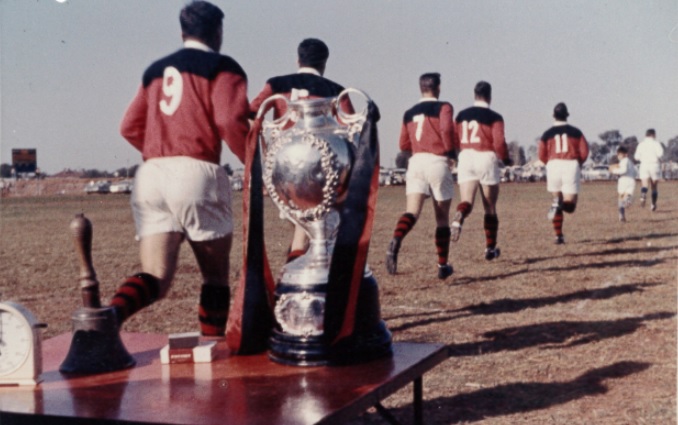
Broadcasting from the Maher Cup game on a cold Tumut day in 1965. The 2LF callers are John Ringwood and Bill Dennis. Behind them, Grenfell reserve Wally Gam tries to keep warm. Photo: Tumut RSL Club collection.
For five decades, battles were waged, wagers won and lost, rabbit-infested ploughed paddock pitches perpetually invaded, yet song, poetry and prose were stirred over a trophy known as “the old tin pot”, which forged a culture in the South West Slopes and Northern Riverina.
And now that trophy has inspired an important historical record that documents the matches, stories, legends and lore that were the Maher Cup in a book, the first authored by Neil Pollock.
A lad born in West Wyalong in 1952 and raised on farms at Wyalong and Caragabal before his family moved to Young, Neil says his childhood memories were studded with Maher Cup moments: late nights after long car trips back from faraway towns such as Gundagai and Tumut, his first traffic jam when returning to Wyalong from a match at Barmedman and listening to the warm-toned calls of John O’Reilly on Young radio station 2LF.
“I played with little talent as a teenager for Grenfell, where I attended high school,” Neil said, “I particularly remembered playing at Young in a match in which I first both observed the falling of snow and questioned why anyone would play this game.”
But in late 2013, with the death of the hero from his school days, Ron Crowe, Neil felt the memories of the era seemed to be fading.
“I decided to attempt to revive the memory,” he said.
A website that segued into a Facebook page has now become a book that’s now lining the shelves of bookstores throughout Group 9 rugby league territory.
The 876-page The Maher Cup – A Social History of Football in NSW’s Group 9 Towns (1920-1971) offers an elaborate history of one of the most significant regional rugby league challenges played in Australia.
A rugby league book like no other, it offers an encyclopaedic listing of more than 3000 players in descriptions of all 729 matches in Australia’s most famous (and infamous) country rugby league competition, complete with scorers, gates and referees and about 250 photos.
Moreover, it offers an insight into the culture of footy in the country.
Maher Cup matches, Neil said, were usually rugged affairs with protests and disputes common, and injuries and dismissals routine.
Games were played during floods, snow and other adverse weather conditions and gambling was essential, he said.
The winning team would have the right to contest all subsequent challenges on its home ground and (in the early years) would retain the gate-takings.
About 15 to 20 challenges were usually played each year, the peak being 24 in 1953.
When the cup was newly captured, celebrations would normally start as the team returned home. In the 1920s and ’30s, these trips were usually by special train, horn sounding and carriages full of noisy supporters, Neil said.
“Typically, the town band would lead a cavalcade of revellers carrying the cup and players to an impromptu civic reception,” he said.
”Often, hastily organised entertainment, such as dances, followed late into the evening. Substantial financial gifts may be placed in the cup for the benefit of these local heroes; for to be a Maher Cup player was to be somebody of note in the community.”
The Maher Cup – stolen, vandalised and dumped, even spending a night in jail for safekeeping – always produced colourful stories.
There were tales of referees being bribed, knocked out, attacked by women and refusing to adjudicate due to general player mayhem.
This amid claims of teams being unfairly stacked with short-term imports, footballers bribed to lose and even “ring-ins”.
At one time in Gundagai, nuns needed to fight a house blaze themselves due to the brigade, as well as almost everyone else in town, attending the Maher Cup, Neil said.

Author Neil Pollock’s childhood hero, the tough and unmistakable Ron ”Dookie” Crowe, leads his team out onto a typically dry West Wyalong field. A fearsome place to play. Photo: Neil Pollock.
Neil’s book paints with a broad brush the context of Maher Cup mania, including the place of pubs, SP bookmakers, local newspapers, radio station 2LF, priests and particularly the railway network in the age of steam.
It tackles topics often overlooked, such as blindness toward Indigenous talent, women’s contribution, the importance of Greek-run cafes and picture theatres, how changing technology changed football, as well as politics, protests, personalities, punters, pile drivers, potholes, pugilism and peregrinations.
Neil says the book, like the competition, doesn’t back away from the assertion that the professionalisation of rugby league started not in the city but in Group 9, that the replacement of rugby union with league in the bush had little to do with class conflict and the failures by Country Rugby League to fulfil its charter.
“In a competition in which 40 Australian internationals played, the dominant movement of quality players was from the city to the more prosperous country clubs until the introduction of poker machines in the late 1950s,” Neil said.
He said the book idea didn’t come to him until about 2017 when he got sick of writing and wanted to see the history in print rather than digital format.
The feedback, he said, had been excellent. The first run is almost sold out – with 765 of 1005 copies sold since April.
“People have been amazed at the detail,” he said. “I thought some people would complain about some stuff I wrote, but no.
“And fortunately, no-one has complained about the typos and poor grammar yet.”
Now Neil is immersed in researching the first year of the Wyalong goldfields and the role of two jailed Broken Hill strike miners who, upon release, became driving forces for the town’s improvement.
For further details, head to the Maher Cup website.







